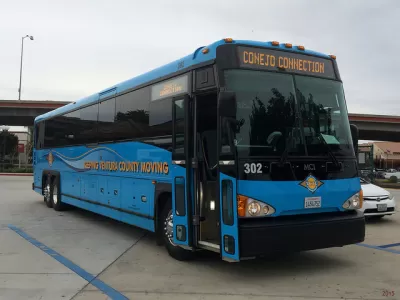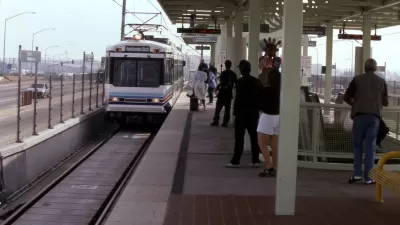Ventura County's transportation sales tax measure failed after receiving almost 57 percent of the vote, illustrating the difficulty in passing tax measures intended for transportation improvements in California.

Many unsuccessful tax measures in California receive a greater percentage of votes than taxes that pass in other states, but the 1978 Proposition 13 sets the threshold for passage at two-thirds for taxes intended for specific purposes, rather than going to a general fund.
"To get to a two-thirds vote, you have to be perfect," said Darren Kettle, executive director of the Ventura County Transportation Commission which sponsored the measure, at an event at the Ventura County Community Foundation in Camarillo, according to Mike Harris, transportation reporter for the Ventura County Star.
According to the ballot language [PDF], voters were asked to increase the county sales tax "by one-half cent for thirty years, raising $70 million annually, with independent oversight and audits, and with all funds benefiting local residents to help preserve Ventura County’s quality of life by:
...fixing potholes, repaving streets, repairing bridges; improving traffic flow and safety on 101 and 118; keeping senior, veteran, disabled, and student bus fares affordable; increasing bicycle and pedestrian safety; protecting waterways and beaches from polluted runoff and restoring watersheds;"
"Under the plan, 50 percent of sales tax funds will be allocated to Ventura County’s 10 cities and the County of Ventura for local transportation priorities," according to the transportation commission. "Over thirty years that translates to about $1.65 billion for improving local roads, filling portholes and building bike paths and sidewalks." The same amount would be raised for county transportation improvements.
Kettle ascribes five reasons for the measure's failure to achieve a 'yes' vote from 66.67 percent of voters:
- Competing sales tax measures in Ventura, known officially as the City of San Buenaventura, Measure O, and Santa Paula, Measure T. Both measures directed revenue to their cities' general funds. Each passed with 57.5 percent of the vote.
- Competition for donations from the much larger Measure M in neighboring Los Angeles County, according to the campaign committee, Citizens for Traffic Relief,
- "Measure AA competed for voters' attention with Measure C, the Ventura County Save Open-space & Agricultural Resources [SOAR] initiative, Kettle said." It passed with almost 59 percent of the vote. Obviously voters hadn't read a critical Planetizen post on that initiative. Voter rejected a competing SOAR initiative, Measure F, which would have loosened restrictions for farmers.
- A well-funded opposition committee — "Stop New Big $3.3 Billion Tax — led by Ventura County Supervisor Peter Foy and former Rep. Elton Gallegly, R-Simi Valley, Kettle said."
- It didn't help that Harris' paper editorialized against the measure, which the opponents used to full advantage. The paper opposed the measure because the "dilution of the impact of the money...creates a fatal flaw in the measure."
- "Even though these dollars are intended to augment current funding, we can envision cities shifting general funds they had designated for transportation to other needs, which means their residents might not receive any additional transportation projects for their additional sales tax," they argued. However, Kettle noted that the measure passed in all ten cities.
- The same paper editorialized in support Measure T, a 1 percent, general sales tax measure for the city of Santa Paula that was approved with 57.5 percent of the vote.
As a result, Ventura County remains "the only Southern California county without a piece of its sales tax being designated for transportation," observed the Star.
Comparison to Bay Area transportation measures
Planetizen observed that while the three-county BART property tax, Measure RR, passed in the Bay Area with 70.7 percent of the vote, voters in two of the counties rejected city transportation taxes. The reverse was true in Ventura County, where voters approved two city transportation taxes but rejected the county tax. Voters may have their own threshold when it comes to tax increase measures: two is one too much.
The analogy doesn't fit entirely as voters in Contra Costa County didn't support Measure RR with two-thirds of the vote, but voters in Alameda and San Francisco County made up the difference.
One final observation: Ventura County had a remarkable ballot this November, using every letter of the alphabet to describe the 26 city and county measures in addition to Measure AA. Of the 27 ballot measures, only three were defeated.
Hat tip to Metro's L.A. Transportation Headlines.
FULL STORY: Factors cited in defeat of transit tax

Alabama: Trump Terminates Settlements for Black Communities Harmed By Raw Sewage
Trump deemed the landmark civil rights agreement “illegal DEI and environmental justice policy.”

Study: Maui’s Plan to Convert Vacation Rentals to Long-Term Housing Could Cause Nearly $1 Billion Economic Loss
The plan would reduce visitor accommodation by 25% resulting in 1,900 jobs lost.

Planetizen Federal Action Tracker
A weekly monitor of how Trump’s orders and actions are impacting planners and planning in America.

Waymo Gets Permission to Map SF’s Market Street
If allowed to operate on the traffic-restricted street, Waymo’s autonomous taxis would have a leg up over ride-hailing competitors — and counter the city’s efforts to grow bike and pedestrian on the thoroughfare.

Parklet Symposium Highlights the Success of Shared Spaces
Parklets got a boost during the Covid-19 pandemic, when the concept was translated to outdoor dining programs that offered restaurants a lifeline during the shutdown.

Federal Homelessness Agency Places Entire Staff on Leave
The U.S. Interagency Council on Homelessness is the only federal agency dedicated to preventing and ending homelessness.
Urban Design for Planners 1: Software Tools
This six-course series explores essential urban design concepts using open source software and equips planners with the tools they need to participate fully in the urban design process.
Planning for Universal Design
Learn the tools for implementing Universal Design in planning regulations.
Caltrans
Smith Gee Studio
Institute for Housing and Urban Development Studies (IHS)
City of Grandview
Harvard GSD Executive Education
Toledo-Lucas County Plan Commissions
Salt Lake City
NYU Wagner Graduate School of Public Service





























